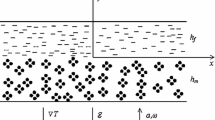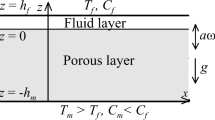Abstract
The interaction between vibrational excitation and chemical reactions in high-temperature flows is examined through an example of a typical boundary-layer, i.e. the thermal layer generated by a shock wave reflecting at the end-wall of a shock-tube. During the development of this boundary-layer in space and time, particular features are pointed out, like the existence of a freezing zone close to the wall, responsible of dissociation rate constants remaining significant in this zone where the translational temperature is decreasing. The catalytic role of the wall is also examined and its influence is important on the vibrational temperature profiles and therefore on the rate constants themselves.
Similar content being viewed by others
References
Marrone P.V., Treanor C.E. (1963) Chemical relaxation with preferential dissociation from excited vibrational levels. Phys. Fluids 6(9): 1215–1221
Macheret, S.O., Rich, J.W.: Theory of non-equilibrium dissociation rates behind strong waves. AIAA Paper 93–2860 (1993)
Capitelli M., Dilonardo M. (1978) Nonequilibrium dissociation of nitrogen. Rev. Phys. Appl. 13, 379–390
Kovach E.A., Losev S.A., Sergievskaia A.L. (1995) Two temperature kinetic models for dissociation of molecules in strong shock-waves. Chem. Phys. Rep. 14(5): 1353–1387
Macheret, S.O., Fridmann, A.A., Adamovich, IV, Rich, J.W., Treanor, C.E.: Mechanisms of non-equilibrium dissociation of diatomic molecules. AIAA Paper 94–1984 (1994)
Kuznetsov NB (1971) Kinetics of molecules dissociation in molecular gas. Sov. J. Theor. Exp. 7(1): 22–23
Treanor C.E., Marrone P.V. (1962) Effect of dissociation on the rate of vibrational relaxation. Phys. Fluids 5(9): 1022–1027
Park C (1988) Assesment of a two-temperature model for dissociating and weakly ionizing nitrogen. J. Therm. Heat Transf. 2(1): 8–16
Kogan, M.N., Galkin, V.S., Makashev, N.K.: Generalized Chapman-Enskog method: Derivation of the non-equilibrium gasdynamics equations. In: Campargue R (ed) Rarefied Gas Dynamics. CEA, Paris, 693–734 (1979)
Brun, R., Vila, M.P., Meolans, J.G.: Generalized transport terms in vibrationally relaxing flows. In: Oguchi, M. (ed) Rarefied Gas Dynamics, Univ. Tokyo Press, Tokyo, 593–599 (1984)
Belouaggadia N., Brun R. (1998) Chemical rate constants in non-equilibrium flows. J Therm. Heat Transf. 12(4): 482–488
Park C Review of finite-rate chemistry models for air dissociation and ionisation
Brun, R.: (1988) Transport properties in reactive gas flows. AIAA Paper 88–2655 (1996)
Park, C.: On convergence of computation of chemically reacting flows. AIAA Paper 85–0247 (1985)
Millikan R.C., White D.R. (1963) Systematics of vibrational relaxation. J. Chem. Phys. 39, 3209–3213
Park C.: Non-equilibrium Hypersonic Aerothermodynamics. Wiley and Sons, New-York
Brun R (1991) Transport phenomena in relaxing gas mixtures: Models and applications. In: Beylich, A.E. (ed) Rarefied Gas Dynamics, VCH Verlagsgesellschaft mbh, Weinheim, 379–390 (1990)
Wilke C.R.: A viscosity equation for gas mixtures. J. Chem. Phys. 18, 4
Pascal S., Brun R. (1993) Transport properties in non-equilibrium gas mixtures. Phys Rev. 47(5): 3251–3267
Brun R., Moustaghfir A.K., Meolans J.G. (1997) Gas-wall interaction in vibrational non-equilibrium flows. In: Houwing AFP (eds) Shock Waves, Paper 1621, Proceedings of 21st ISSW. Geat Keppel, Australia
Author information
Authors and Affiliations
Corresponding author
Additional information
Communicated by K. Takayama.
Rights and permissions
About this article
Cite this article
Belouaggadia, N., Brun, R. & Takayama, K. Characteristic features of boundary-layers in vibration–dissociation non-equilibrium. Shock Waves 16, 17–23 (2006). https://doi.org/10.1007/s00193-006-0045-y
Received:
Accepted:
Published:
Issue Date:
DOI: https://doi.org/10.1007/s00193-006-0045-y




